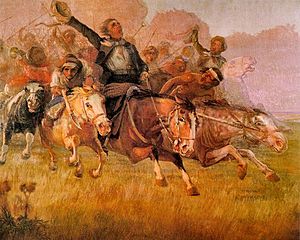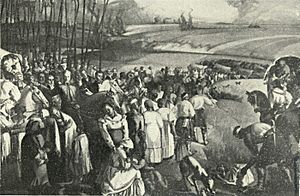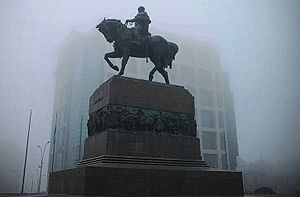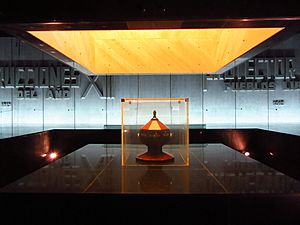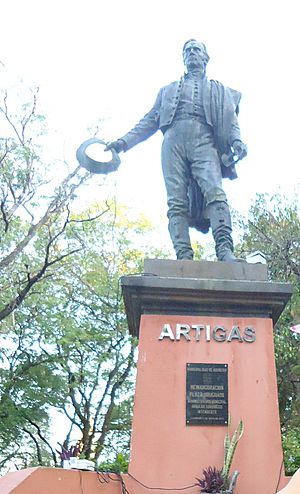José Gervasio Artigas facts for kids
Quick facts for kids
José Gervasio Artigas
|
|
|---|---|
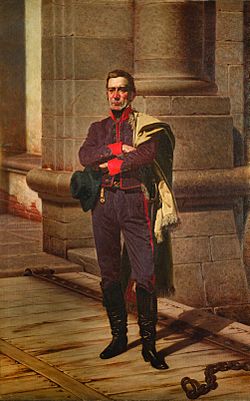
Artigas en la Ciudadela by Juan Manuel Blanes
|
|
| Nickname(s) | Karaí-Guasú |
| Born | June 19, 1764 Montevideo |
| Died | September 23, 1850 (aged 86) Asunción, Paraguay |
| Buried | |
| Allegiance | Provincias Unidas del Rio de la Plata |
| Years of service | 1797– |
| Rank | General |
| Battles/wars | British invasions of the Río de la Plata Portuguese invasion of the Banda Oriental (1811–12) Argentine War of Independence Portuguese conquest of the Banda Oriental Argentine Civil Wars |
| Signature | |
José Gervasio Artigas Arnal (born June 19, 1764 – died September 23, 1850) is a very important national hero of Uruguay. Many people call him "the father of Uruguayan nationhood" because he played a huge role in creating the country.
Contents
Biography
Growing Up and Early Career
José Artigas was born in Montevideo on June 19, 1764. His family was quite wealthy. His parents sent him to a school to study religion, but Artigas didn't like the strict rules there. He left school but made a good friend named Fernando Otorgues, who would later help him a lot.
When he was 12, Artigas moved to the countryside. He worked on his family's farms. Living among gauchos (South American cowboys) and native people taught him a lot. As he grew older, he started smuggling cattle. This made him an enemy of landowners and the government in Montevideo. They even offered a reward for his capture.
Things changed when the war between Spain and Britain began. The British threatened to attack the region. The Spanish leader in the area, Antonio de Olaguer y Feliú, offered Artigas a deal. If Artigas joined the army with a hundred men, he would be pardoned. Artigas agreed and began his military career in 1797, at age 33.
Fighting the British
In 1806, the British attacked Buenos Aires. Artigas wanted to help fight them, even though his unit was supposed to patrol the border with Brazil. His request was approved, and the British were defeated. After this victory, Artigas was sent to tell the governor in Montevideo the good news.
A second British attack aimed to capture Montevideo. The city was taken in the Battle of Montevideo. Artigas was captured, but he managed to escape. He went back to the countryside and organized groups of gauchos. They started a guerrilla war against the British. The British tried to capture Buenos Aires again but were defeated. They returned Montevideo to Spanish control. Artigas was promoted to captain in 1809.
The Oriental Revolution Begins
New ideas about freedom and government were spreading. Also, Spain's king, Ferdinand VII, was captured by the French. These events led to the Spanish American wars of independence. People called "patriots" wanted to create new republics, while "royalists" wanted to keep the Spanish king in charge.
Artigas supported the new ideas. He felt that the gauchos were not treated fairly by the Spanish rulers. In 1810, Buenos Aires removed the Spanish leader there. They formed a new government called the Primera Junta. This new government saw Artigas as a key ally against the royalists in Montevideo.
Artigas went to Buenos Aires, but he didn't get much help. He was promoted to colonel and received some weapons and men, but it wasn't enough to start a big rebellion. This was the last time Artigas visited Buenos Aires.
Spain then made Montevideo the new capital of the region. The new Spanish leader, Francisco Javier de Elío, made unpopular decisions to pay for his army. This made many people in the countryside angry. Artigas used this anger to start a rebellion against the Spanish.
A group of a hundred men met and made the cry of Asencio. This was a public statement against the Spanish leader. They quickly captured many villages in the region, including Mercedes and Maldonado. They also took control of areas west of the Uruguay River.
Elío tried to stop Artigas by sending soldiers to kill him. When that failed, he offered Artigas a pardon and a high military rank if he stopped the rebellion. Artigas saw this as an insult and sent Elío's messenger to Buenos Aires as a prisoner.
Soon, Artigas's forces surrounded Montevideo. A battle took place at Battle of Las Piedras, where Artigas's forces won. The city was then put under siege. Forces from Buenos Aires, led by José Rondeau, joined the siege. Artigas wanted to attack the city right away, but Rondeau preferred to wait for the city to surrender. However, Montevideo's navy kept the city supplied, so it didn't surrender easily.
Troubles and the Oriental Exodus
Facing defeat, the Spanish leader in Montevideo, Elío, asked for help from Brazil. Brazilian forces, led by Diogo de Sousa, entered the region with a large army. At the same time, other patriot armies were losing battles elsewhere.
Fearing a complete defeat, Buenos Aires signed a truce with Elío. This agreement recognized Elío as the ruler of the region. Artigas felt this was a betrayal. He broke off relations with Buenos Aires and ended the siege of Montevideo.
Artigas then left the region and moved to Salto Chico. All his supporters, thousands of people, moved with him. This massive departure is known as the Oriental exodus.
The leader in Buenos Aires, Gervasio Antonio de Posadas, offered a reward for Artigas's capture, dead or alive. This only made the people who followed Artigas even more angry at Buenos Aires. Some Spanish leaders even tried to get Artigas to join them against Buenos Aires, but he refused. He said he only wanted his nation to be free from Spanish rule.
Artigas still wanted to work with Buenos Aires, but only if they agreed to a system where the provinces had more power, like a federation. Posadas, who wanted Buenos Aires to have central control, delayed agreeing to this.
Buenos Aires then restarted military actions against Montevideo. This time, their navy, led by William Brown, helped them defeat Montevideo's navy. Carlos María de Alvear led the capture of Montevideo. He tried to trick Artigas into coming to the city by promising to hand it over to him. But Alvear attacked Artigas's forces, though Artigas managed to escape.
The Federal League
In 1814, Artigas created the Liga de los Pueblos Libres (League of the Free Peoples). He was declared its Protector. The next year, he freed Montevideo from the control of Buenos Aires.
In 1815, Artigas held a meeting called the Congress of Oriente. Here, several provinces, including the Oriental Province (which is now Uruguay), Córdoba, Corrientes, Entre Ríos, Misiones, and Santa Fe, declared their independence from Spain. They formed the Liga Federal ("Federal League"). The League invited other provinces to join them under a federal system, where each region had more control.
At this meeting, Artigas also changed the flag created by Manuel Belgrano. He added a red diagonal stripe, which was the color of federalism at that time.
Portuguese Invasion and Exile
The growing power of the Federal League worried both Buenos Aires (because of its federal ideas) and Portugal (because of its republican ideas). In August 1816, Portugal invaded the Eastern Province. Buenos Aires quietly allowed this to happen. Portugal wanted to destroy Artigas and his revolution.
Portuguese forces, led by Carlos Frederico Lecor, captured Artigas and his officers. They occupied Montevideo in January 1817. However, the fight continued in the countryside for three more years. Artigas was angry that Buenos Aires did nothing to help. He even declared war on Buenos Aires while still fighting the Portuguese.
Some of his allies, like Francisco Ramírez and Estanislao López, managed to defeat the central government of Buenos Aires. But their hope for a new nation didn't last. These commanders made agreements with Buenos Aires that went against Artigas's ideas. They turned against him, leaving him to be defeated by the Portuguese.
Without soldiers or supplies, Artigas retreated to Paraguay in September 1820. In Paraguay, the leader, Dr. Francia, sent him away to a remote area. Artigas then disappeared from the political scene.
After a long exile, Artigas died in Paraguay in 1850, at the age of 86. It is said that he asked for a horse and died in the saddle, like a true gaucho. His remains were buried and later moved to the Panteón Nacional in 1855. On June 19, 1977, his remains were moved again to the Artigas Mausoleum in the center of Plaza Independencia in Montevideo.
Artigas's Ideas
Artigas strongly believed in democracy and federalism. He was against monarchies (rule by a king) and centralism (where one main city controls everything).
His ideas came from American thinkers like Thomas Paine and French thinkers like Jean-Jacques Rousseau. Artigas read books like Paine's "Common Sense" and Rousseau's "The Social Contract" when he was young. Historians have found that some parts of Artigas's writings were taken directly from American legal texts. This shows how much American political ideas influenced him. Other independence leaders in the region were more influenced by the French Revolution.
Legacy
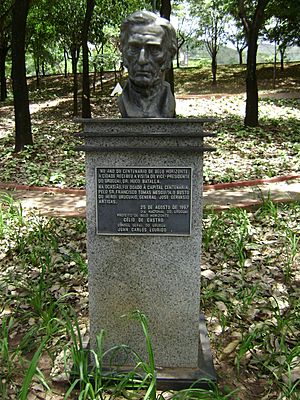
Artigas has become a national hero in Uruguay. This is special because many Uruguayan heroes are only celebrated by one political party. Artigas, however, is respected by everyone. Because of this, many places and things in Uruguay are named after him, especially during times of peace.
- Artigas Department, the northernmost region of Uruguay.
- Artigas, its capital city.
- Artigas Airport.
- General Artigas Bridge, connecting Paysandú, Uruguay and Colón, Argentina.
- Fort General Artigas, a military museum in Montevideo.
- General Artigas Military Club in Montevideo.
- General Artigas Military School in Montevideo.
- Artigas Base, Uruguay's research station in Antarctica.
- The Uruguayan 1st Cavalry Regiment.
- Several ships of the Uruguayan Navy have been named ROU General Artigas or ROU Artigas.
- The Flag of Artigas, which flies outside Uruguayan government buildings and is used by the Armed Forces.
Artigas's birthday, June 19, is celebrated as a national holiday in Uruguay.
Statues of José Artigas can be found in many cities around the world. These include Washington, D.C., New York, Caracas, Athens, Mexico City, Newark, New Jersey, Quito, Montevideo, Minnesota, Punta del Este, Asunción, and Buenos Aires. There is also a monument in Rome, Italy, and in Bucharest, Romania, and Sofia, Bulgaria. A street in New Delhi, India, is named Jose Artigas Marg.
An extinct giant rodent genus, Josephoartigasia, was named after him.
There is also an award, the Order of Military Merit of the Companions of Artigas, created in 1980.
Images for kids
-
Equestrian monument of Artigas in Minas, Uruguay.
See also
 In Spanish: José Gervasio Artigas para niños
In Spanish: José Gervasio Artigas para niños


